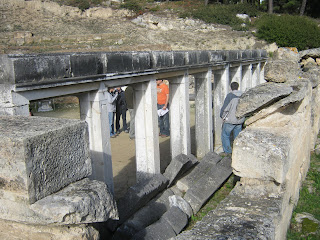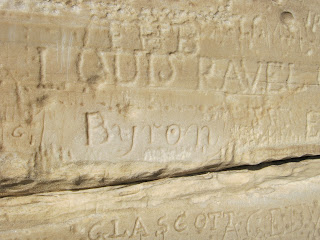Leaslie Threatte joined our Epigram class on Monday going over letter forms, dialect, alphabet, and other issues in a number of inscribed epigrams.
Tuesday morning was rainy as we climbed up to the caves on the North Slope of the Acropolis. There Stephanie gave her report on the Sanctuary of Aphrodite and Eros and the Cave of Aglauros.
Next we headed down to the area of the City Eleusinion where the foundations of a temple remain.
Then it was up to the deme site where Ben gave his report.
Tuesday morning was rainy as we climbed up to the caves on the North Slope of the Acropolis. There Stephanie gave her report on the Sanctuary of Aphrodite and Eros and the Cave of Aglauros.
 |
| From inside the Cave of Aglauros |
Next we headed down to the area of the City Eleusinion where the foundations of a temple remain.
Simon then led us along the Street of the Tripods, pointing out possible places (covered over with modern buildings) for the missing buildings of the archaic Agora. He then talked about current theories about the location of the agora, the buildings we know existed because they were mentioned in literature, including the Prytaneium.
On the road of the Tripods, is the Lysikrates monument, where I gave my report. It was raining again by then and I didn't get any good pictures. Here's a blurry one to be replaced eventually by a better one.
In ancient times, there would have been a bronze tripod on top, commemorating Lysikrates' victory as a chorus leader in the boys' chorus competition.
Wednesday's trip began at Rhamnous at the Sanctuary of Nemesis.
After looking around the site, the guard allowed us in to the apotheke where the remains of the superstructure have been put back together according to Margie's published reconstruction.
 |
| Inside the reconstructed temple |
Then it was up to the deme site where Ben gave his report.
Before moving on, we had a picnic lunch under this very large and very lovely tree.
Our next stop was at Oropos where there's a temple of Amphiaraos, on which Jess gave her report,
a theater,
a Doric stoa,
and a water clock.
The last stop of the day was at Aulis, famous for being the place where Agamemnon had to sacrifice his daughter Iphigenia in order to sail to Troy. Kyle gave his report on the temple of Artemis there.
Across the street and over a fence, we had a look at the fountain house.
On Thursday our Epigram class met for a second time. We spent the first part of the morning at the Kerameikos museum looking at inscriptions. Sarah, Allie (in absentia), and I worked on this funerary inscription for an Olympic victor.
We then went outside to the site and looked at the inscriptions on this monument.
We finished the morning at the Acropolis Museum but, again, no pictures are allowed.
On Friday we had our first session at the Agora with John Camp, this time focusing on archaic buildings. We couldn't get down to look at the Royal Stoa closely because of the water but maybe we'll get a chance next week.
We did get to look at some archaic walls and foundations for buildings, a shrine, and a fountain house.




























































